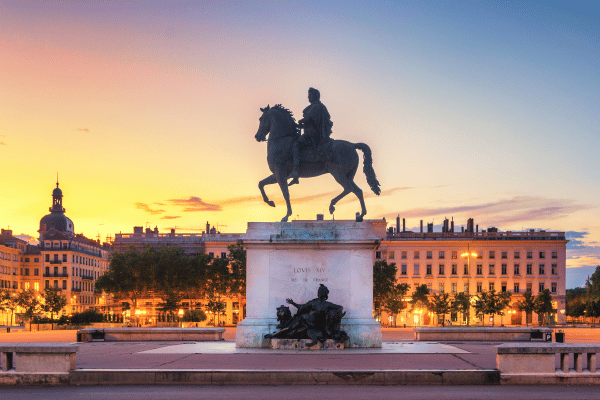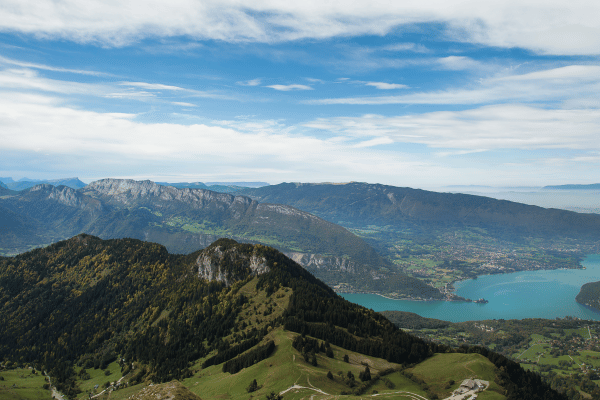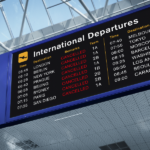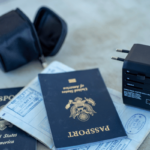Discover the charm of France with our guide, ‘Navigating France by Train’. Ideal for travel enthusiasts seeking efficient and scenic journeys across this picturesque country.
Efficient Travel: France’s Train Network

Embarking on a journey through France by train is not only efficient but also enchanting. The country’s extensive rail network connects major cities and quaint villages alike, offering a window to France’s diverse landscapes. From the bustling streets of Paris to the lavender fields of Provence, each route presents a unique tapestry of sights. Moreover, French trains are known for their punctuality, making them a reliable choice for travelers.
For those seeking a blend of comfort and adventure, France’s trains provide various classes of service. Whether you opt for the high-speed TGV or the regional TER, each train offers a distinct experience. First-class seats ensure a luxurious journey, while second-class offers practical affordability. Furthermore, many trains are equipped with amenities like Wi-Fi, enhancing the travel experience. Traversing France by train becomes not just a journey, but a memorable part of your adventure.
Planning your train travels in France is straightforward, thanks to user-friendly online platforms. Reserving tickets in advance can save money, and e-tickets offer convenience. For extensive travel, consider a rail pass like the Eurail or Interrail, providing flexibility and value. Additionally, night trains are an excellent option for covering long distances without losing a day. By train, you can seamlessly integrate various destinations into your travel itinerary, making the most of your French escapade.
Paris: Exploring France’s Iconic Capital
Paris, the quintessential destination for any traveler in France, is best explored by train. The city’s extensive rail system, including the famous Metro, connects all major attractions efficiently. Starting from the historic Gare du Nord, one can reach landmarks like the Eiffel Tower and Louvre with ease. Moreover, trains in Paris are frequent and reliable, offering a glimpse into the everyday life of Parisians as you move from one arrondissement to another.
The charm of Paris lies in its blend of history and modernity, which is evident in its train stations. For instance, Saint-Lazare Station, depicted in numerous Impressionist paintings, still stands as a bustling hub. Additionally, the RER trains connect Paris to its suburbs, including the must-visit Palace of Versailles. These trains are not just modes of transport but portals to a richer understanding of French culture and heritage.
Navigating Paris by train also offers unexpected delights. Small bistros near stations, local markets, and hidden gardens are easily accessible. For an authentic experience, take a train to the Montmartre district and stroll through its artistic streets. Remember, while the Paris Metro is convenient, it’s also important to stay aware of your surroundings and keep your belongings secure. Overall, trains in Paris provide a practical, immersive way to experience the city’s vibrant life.
Lyon: Culinary Delights and Scenic Journeys

Lyon, renowned for its culinary excellence, is easily navigable by train. This gastronomic haven is a short train ride from Paris, with TGV services offering swift and comfortable travel. Upon arrival, Lyon’s Part-Dieu station places you in the heart of the city. Here, one can embark on a culinary journey, exploring traditional bouchons and tasting exquisite local wines. The accessibility of Lyon by train makes it an irresistible stop for food enthusiasts exploring France.
Beyond its cuisine, Lyon’s historical and architectural treasures are within reach by train. The city’s two rivers, the Rhône and Saône, are lined with stunning views, easily enjoyed through a train window. A visit to Vieux Lyon, the old town, is a must. This UNESCO World Heritage site, with its Renaissance architecture, is a delightful stroll away from Lyon’s train stations. Trains provide a seamless connection between Lyon’s gourmet delights and its cultural heritage.
For those venturing outside Lyon, regional trains offer scenic routes to the Beaujolais wine region or the medieval town of Pérouges. These destinations, known for their picturesque landscapes and historic significance, are perfect day trips by train. Furthermore, Lyon acts as a gateway to the Alps, with trains heading towards mountainous adventures. Thus, Lyon’s train network not only serves the city but also connects travelers to the broader splendors of the Rhône-Alpes region.
Provence: Navigating France’s Lavender Fields
Provence, a region synonymous with lavender fields and sun-kissed villages, is a dream destination best explored by train. The train journey to Provence from Paris, through the TGV, is both efficient and scenic. As you near Provence, the landscape transforms into rolling hills and vineyards. Stations like Avignon TGV provide easy access to the region’s highlights. Train travel here isn’t just about reaching a destination; it’s an immersive experience into the heart of southern France.
In Provence, the train routes are like moving postcards. The scenic journey from Avignon to Marseille, for instance, offers panoramic views of the Mediterranean coast. Small towns such as Arles and Aix-en-Provence, famous for their historical and artistic heritage, are conveniently connected by regional trains. These trains are not just transport; they’re a journey through time, revealing the region’s Roman history and the landscapes that inspired artists like Van Gogh.
During summer, the lavender fields of Provence are in full bloom, creating a spectacular sight best seen by train. The route from Avignon to Valensole is particularly breathtaking. Additionally, Provence’s train stations are gateways to local experiences, from wine-tasting tours to hiking trails. The region’s well-connected train network ensures that each journey leads to unique discoveries, making it a top choice for travelers seeking both relaxation and adventure in France.
French Riviera: Coastal Charm by Train
The French Riviera, or Côte d’Azur, is a splendid region best experienced by train. Trains along this Mediterranean coast offer breathtaking views, connecting major cities like Nice, Cannes, and Monaco. The journey is not only scenic but also convenient, avoiding the heavy traffic often found on roads. Starting from Marseille, the train ride along the coast is a visual treat, showcasing the azure waters and vibrant towns that define the Riviera’s allure.
Each stop along the French Riviera presents its own charm. Nice, with its picturesque Promenade des Anglais, is a short train ride away from the artistic haven of Saint-Paul-de-Vence. Cannes, famous for its film festival, offers glamorous beaches and boutique shopping, easily accessible by train. Even the opulent Monaco, known for its grand casino and luxury yachts, is a straightforward train journey, allowing visitors to experience the high life without the high costs.
Beyond the glamour, the Riviera’s train routes lead to lesser-known gems. The coastal train to the Italian border town of Menton reveals hidden beaches and quiet coves. For nature enthusiasts, the Train des Merveilles from Nice ventures into the Alps, offering stunning mountain views. This versatility makes the French Riviera’s train network a perfect choice for travelers seeking both the glitz of beachfront cities and the tranquility of the Mediterranean countryside.
Bordeaux: Wine Adventures by Train
Bordeaux, a city synonymous with world-class wines, is a destination made accessible and enjoyable by train. The high-speed TGV connects Paris to Bordeaux in just two hours, a testament to the efficiency of French rail travel. Upon arrival, Bordeaux’s St-Jean station is a gateway to the city’s renowned vineyards and châteaux. Here, train travel merges with wine tourism, offering a unique and sophisticated way to experience one of France’s most celebrated regions.
The charm of Bordeaux extends beyond its wines. The city itself, a UNESCO World Heritage site, is rich in history and architecture, easily navigable by its comprehensive tram system. The train journey from Bordeaux to the medieval town of Saint-Émilion, famous for its vineyards, is a short and scenic route. This journey reveals the diverse landscapes of the region, from rolling hills to historic estates, encapsulating the essence of French viticulture.
For the avid wine enthusiast, regional trains provide access to lesser-known appellations like Médoc and Graves. These areas, with their rustic charm and family-owned wineries, offer intimate tasting experiences. Additionally, the convenience of train travel in Bordeaux allows for safe exploration of multiple wineries in a day. The combination of Bordeaux’s picturesque vineyards and its efficient rail network presents a perfect blend for those seeking a leisurely yet enriching travel experience.
Strasbourg: Cross-Cultural Charm by Train
Strasbourg, nestled on the border of France and Germany, offers a unique cultural blend, best explored by train. The city is a fusion of French and German influences, evident in its architecture and cuisine. Arriving by train, visitors are greeted by the impressive Strasbourg station, a symbol of the city’s connectivity. From here, one can easily explore the picturesque ‘Petite France’ district, a maze of cobblestone streets, half-timbered houses, and canal views.
The train journey to Strasbourg itself is a scenic route, passing through diverse landscapes of the Alsace region. High-speed TGV services link Strasbourg to Paris and other major cities, making it a convenient gateway to the east of France. The city’s tram network complements its train services, providing easy access to landmarks like the Strasbourg Cathedral and the European Parliament. This seamless blend of transportation options makes Strasbourg an ideal destination for culturally curious travelers.
Beyond the city, regional trains from Strasbourg lead to charming Alsace villages like Colmar and Riquewihr. These destinations, known for their colorful buildings and vineyards, are perfect for day trips. The region’s famous Wine Route is also accessible by train, offering a journey through picturesque towns and lush vineyards. Thus, Strasbourg’s train network is not just a means of transport; it’s a gateway to exploring the rich cultural tapestry of the Alsace region.
Normandy: Historical Journeys by Train
Normandy, a region steeped in history and natural beauty, is ideally discovered by train. The rail network here connects travelers to key sites of historical significance, like the D-Day beaches and the medieval city of Rouen. Trains from Paris to Normandy offer a convenient and scenic journey, revealing the lush countryside and coastal landscapes of the region. This ease of access makes Normandy an essential visit for those interested in exploring France’s rich historical tapestry.
Besides its historical sites, Normandy’s train routes also showcase its diverse landscapes. From the iconic cliffs of Étretat to the serene beauty of Mont-Saint-Michel, the region’s natural wonders are accessible by train. The journey from Rouen to the seaside town of Deauville, for instance, offers picturesque views of the Normandy countryside. These train journeys not only connect destinations but also provide a peaceful and immersive travel experience, characteristic of the Normandy region.
Normandy’s culinary delights, particularly its seafood and cheeses, are another highlight accessible by train. Towns like Caen and Bayeux are not just historical centers but also hubs for gastronomic exploration. The local markets near train stations are perfect for sampling regional specialties like Camembert and Calvados. The combination of Normandy’s historical sites, natural beauty, and culinary offerings, all connected by its efficient train network, creates a multi-faceted travel experience for visitors.
Navigating France’s Loire Valley Elegance
The Loire Valley, often referred to as the ‘Garden of France’, is a splendid region best experienced by train. This area, known for its magnificent châteaux and lush vineyards, is seamlessly connected by a network of trains. Travelers can embark from Paris and soon find themselves amidst the valley’s rolling hills and historic estates. This journey not only offers convenience but also a chance to witness the changing landscapes of France’s countryside.
Each stop in the Loire Valley unveils a part of France’s royal history. Iconic châteaux like Chambord and Chenonceau are just a train ride away, offering insights into the Renaissance era. The regional train services make it easy to hop from one estate to another, making the most of your visit. Additionally, the valley’s smaller towns, accessible by train, provide a glimpse into local life, away from the tourist crowds.
Navigating France by Train through the Loire Valley, celebrated for both its architectural wonders and wines, offers a delightful experience. Towns like Tours and Saumur, connected by train, open doors to exceptional wine-tasting in renowned vineyards. The journey itself, with views of vine-laden hills and historical towns, is captivating. This combination of accessibility and scenic beauty makes the Loire Valley an enchanting and convenient destination for those exploring France’s rich offerings.
Alpine Wonders: Accessible by France’s Trains

The French Alps, a region of majestic mountains and pristine landscapes, are wonderfully accessible by train. This area, a paradise for nature lovers and adventure seekers, is connected by an efficient rail network. Trains from cities like Lyon or Grenoble take you into the heart of the Alps, where the air is crisp and the views are breathtaking. This journey is not just a travel convenience; it’s an introduction to France’s awe-inspiring natural beauty.
The train journey to the Alps is as spectacular as the destination itself. Routes like the Mont Blanc Express offer panoramic views of snow-capped peaks and alpine meadows. Chamonix, a popular alpine town, is easily reachable by train, offering activities from skiing to hiking. These trains not only provide access to outdoor adventures but also offer a serene and scenic travel experience, showcasing the diverse topography of the French landscape.
Beyond adventure sports, the Alps are rich in cultural experiences. Towns like Annecy, with its picturesque lake and canals, blend natural beauty with historical charm. The region’s culinary offerings, including famous cheeses like Reblochon, are a delight to explore. The convenience and comfort of traveling by train through the French Alps allow for a stress-free exploration of both the great outdoors and the cultural heritage of this magnificent part of France.
Brittany’s Coastal Charm Explored by Train
Brittany, a region with a strong Celtic heritage and rugged coastline, is a destination that’s delightfully explored by train. This westernmost part of France, known for its distinct culture and scenic beauty, is well-connected by rail. Trains from Paris to cities like Rennes and Brest offer travelers an opportunity to experience Brittany’s unique charm. The journey through the countryside and along the coast is a prelude to the region’s rich history and natural splendor.
Navigating France by Train through Brittany unveils a landscape adorned with medieval towns, ancient megaliths, and scenic harbors. Destinations like Saint-Malo, celebrated for its walled city and maritime heritage, are effortlessly accessible by train. The regional rail network also connects to hidden gems, immersing travelers in the local Breton culture and language. This ease of travel enhances the exploration of traditions and natural beauty, showcasing Brittany’s distinct charm within France.
Brittany is also celebrated for its culinary delights, particularly seafood and crepes, which are easily explored through its train network. The region’s small towns, many of which are accessible by train, offer authentic dining experiences. Additionally, the coastal trains provide stunning views of the Atlantic Ocean, enhancing the dining experience. The combination of Brittany’s distinct culture, scenic train routes, and delicious cuisine creates a memorable and diverse travel experience for those exploring France.
IN SUMMARY
In conclusion, navigating France by train is not just a mode of transport; it’s a key part of the travel experience. From the historical streets of Paris to the sun-drenched Provence, the diverse regions of France are connected through a comprehensive and efficient train network. This guide has explored various destinations, each offering its unique charm and accessible by train. Train travel in France is an adventure in itself, filled with scenic beauty and cultural insights.
Our journey through France’s regions has revealed that each area offers something special. Whether it’s the culinary wonders of Lyon, the coastal allure of the French Riviera, or the historical richness of Normandy, train travel provides a convenient and immersive way to explore. The train routes themselves are experiences, offering views and comforts that enhance your travel. The ease and efficiency of train travel in France make it an ideal choice for all travelers.
We encourage you to embrace train travel as you explore France. Plan your journey, book your tickets, and embark on a memorable adventure. For more information and tips on traveling in France, visit the official website of the French National Railway Company, SNCF. Share your experiences, suggestions, or questions in the comments below. Let’s continue the conversation and make your next trip to France an unforgettable journey by train.
II. Frenquently Asked Questions About France
- How do I navigate the French healthcare system as a tourist?Ensure you have travel insurance that covers healthcare. Pharmacies are widespread for minor ailments, and emergency services can be contacted by dialing 112.
- What are some popular French festivals to experience?Don't miss the Cannes Film Festival, Bastille Day celebrations, and the Nice Carnival for their vibrant displays of French culture and festivity.
- What are the best regions in France for wine tasting?Visit Bordeaux for reds, Champagne for sparkling wines, Burgundy for Chardonnay and Pinot Noir, and the Loire Valley for a variety of whites.
- How do I respect local customs while visiting religious sites in France?Dress modestly, remain quiet, and follow any posted visitor guidelines to show respect while visiting places like Notre-Dame Cathedral and Mont Saint-Michel.
- What should I know about shopping in France?Shops in smaller towns may close for lunch, sales are state-regulated and occur twice a year, and asking for a "détaxe" form can save tourists on VAT for larger purchases.
- Is tap water safe to drink in France?Yes, tap water is safe to drink in most parts of France, making it both a sustainable and economical choice.
- What are some French etiquette tips for visiting someone's home?Bring a small gift such as wine, flowers, or chocolates. Arrive on time or slightly late, and always remove your shoes if the host does.
- Can you recommend any French books or movies to get inspired before my trip?Movies like "Amélie" and "Midnight in Paris" and books like "A Moveable Feast" by Ernest Hemingway offer enchanting views of France.
- What are the rules for tipping in France?Service charge is included in bills, but leaving an extra 5-10% at restaurants is appreciated for good service.
- How do I use public transport in Paris?To use public transport in Paris, purchase a ticket or pass from metro stations, kiosks, or RATP app. The metro, buses, and trams are interconnected for ease of travel. A single ticket works for a one-way journey, including transfers. Consider a day pass for unlimited travel or a Navigo pass for longer stays. Always validate your ticket before boarding, and keep it until you exit to avoid fines.

Ryan Taylor, a seasoned traveler with over a decade of experience exploring Europe’s nooks and crannies, offers a wealth of knowledge and unique insights into the continent’s diverse cultures and landscapes. His passion for travel began in his early twenties, and since then, Ryan has journeyed through numerous European countries, collecting stories, tips, and a deep understanding of each destination’s unique charm. His blog entries are not just guides but narratives enriched with personal experiences, making every recommendation and piece of advice relatable and practical for fellow travel enthusiasts. With a keen eye for hidden gems and a love for sharing his adventures, Ryan’s writings are a treasure trove for anyone seeking to discover the beauty and richness of Europe.






